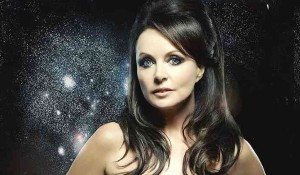Erik, the disfigured phantom of the opera house, had every reason to covet the body, voice and soul of his “Angel of Music,” Christine Daaé. In Andrew Lloyd Webber’s London version of “The Phantom of the Opera,” soprano Sarah Brightman personified the angelic face and voice of Christine. In real life, she was Webber’s muse and wife for six years.
Brightman’s immense talent would help the musical’s original London cast sell over 40 million copies of the CD from its release in 1987, the all-time high for a cast album.
And that’s been her story—going from one shining achievement to another. She has often been credited with creating the classical crossover genre, and setting the bar astronomically high. Worldwide, as a solo artist, she has sold over 30 million records and 2 million DVDs, making her the best-selling soprano of all time. Her 1996 duet with Andrea Bocelli, “Time to Say Goodbye,” sold 12 million copies worldwide; it’s one of the best-selling singles of all time. In 2010, she was named Billboard’s fifth most influential and best-selling classical artist of the decade.
Recently, it was reported that Brightman had booked a 2015 flight with astronauts on a mission to the International Space Station, and had started training. She would be the first singer in outer space, thus, quite literally bringing her career to a new high.
In an exclusive phone interview with the Inquirer last week, Sarah talks about her 11th album, “Dreamchaser,” where she sings about the universe; and a possible second visit and performance in Manila.
It’s midnight in Manila—the perfect time to discuss an album titled “Dreamchaser,” don’t you think?
(Laughter) Yes, it is.
How different is “Dreamchaser” from your previous albums?
It’s still a Sarah Brightman album, but the sound is very different. I worked with a different producer, Mike Hedges, who has produced for groups like U2 and The Cure, and for the singing monk, Friar Alessandro. Mike’s a very spiritual man. He’s the perfect producer for this album. He understood what I wanted to do with it, that I wanted the sound, the theme for the album, to be very expansive, like the universe. He also collected pieces of music that we knew would connect people to their emotions when they think about space.
It was quite a challenging but beautiful journey at the same time. It’s probably one of my most personal albums. It has a huge amount of passion and excitement.
What did you learn from Mike here?
I’ve known Mike since I was 18. There weren’t really any surprises, and I didn’t need any. I needed somebody I could trust and work very carefully with through this. I knew this was going to be a journey, with high and low points, because to try and bridge the gap between space and what’s beyond, that’s quite challenging. When people think of space, it’s quite technical. I took that as a positive thing because I was able to project my voice with an emotional, metaphysical sound into it. Of course, we worked with natural instruments, but we also used different electronic sounds, which shows a more scientific, active music. That’s where Mike came into the picture.
Does “Dreamchaser” capture the “sound” of the universe, then?
Well… there’s actually no sound in space. People who hear the album go, “Oh, it’s space, isn’t it?” I say, “Yes, it is.” They get it completely. There are so many emotions and themes when you sing about the universe—the stars and the planets, the present moving into the future… The images of our planet and the surrounding universe that we get from the Hubble telescope and the International Space Station are mind-blowing. It’s a beautiful palette to work with and gives me a lot of texture.
“Dreamchaser” was first released in Japan. Why was that?
The Japanese wanted to release it in January. We went, “Fine!” But there’s one song in the album (“Closer”) that is not [in the Japanese release] because we were still in the middle [of recording it at the time]. They got a beautiful Japanese song instead (“Path of the Wind”).
How long did the album take to create?
From concept to actual product, about four years. It was the longest of my albums to produce, but not in physical terms. It took that long to think about the songs and find out more about space. I researched, like a director making a movie.
How is your voice evolving?
I love it, I hate it all at the same time (laughs). One day it would do incredible things, and I’d go “Where did that come from?” Another day it just wouldn’t “talk.” As I get older, it becomes quite interesting. I can actually get richer tones in it. It’s surprising sometimes. But it hasn’t changed that much.
Did you play any instruments in this album?
No, because I sang hundreds of voices. We created so many Sarah voices in there. But it’s a lovely idea, one day I will play one.
Does your planned space trip have anything to do with your album?
People often ask why I called the album “Dreamchaser.” I wanted to use the word “dream” because all my life I have been chasing my dreams, and there is a space ship made called Dream Chaser, so I said, it’s the perfect name (for an album).
Can we call it prophetic?
Yes, that’s a beautiful word.
Last time you were in Manila was in 2004. Do you plan to perform here again?
I’d love to come back. I know I have a lot of fans there, so… maybe in 2014, definitely before I go out into space.
(“Dreamchaser” is available in record stores. For details, visit www.facebook.com/mcamusic.ccj.)


